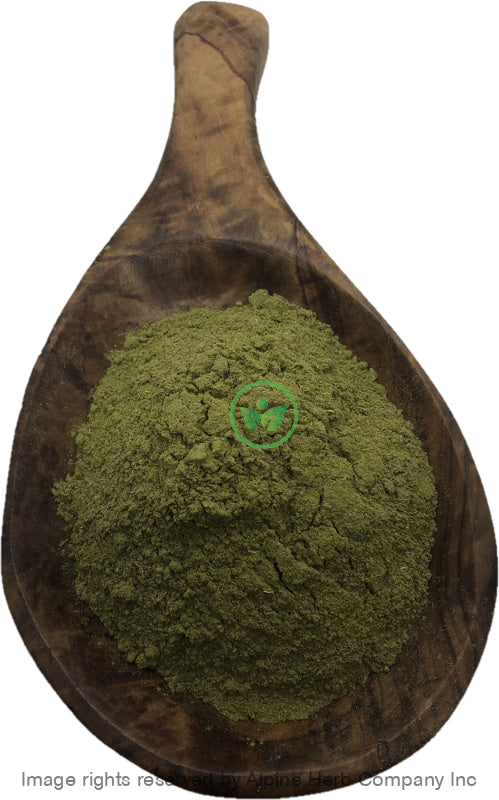Moringa Leaves Powder Alpine Herb Company Inc.
$ 8,99 $ 5,39
Botanical Name: Moringa oleifera
Common Name:
- English: Drum Stick Tree
- Ayurvedic: Shigru (white var.), Madhu Shigru, Sigra, Shobhaanjana
- Unani: Sahajan
- Siddha: Murungai
- Also, known as: Sobhanjana, Bahala, Tiksnaagandh¡, Aksiva, Mocaka, Sajina, Sajna, Sajn, Sargavo, Sekato, Saragavo Parna, Shajoma, Mungna, Neegge, Nugge ele, Murinna, Tishnagandha, Muringa, Muringa Elai, Sevaga, Haritashaaka, Raktaka, Murangi, Mochaka, Akshiva, Tikshnagandhaa, Segata, Segata pana, Shewgachi pane, Sajana, Munga, Munika, Sohanjana, Murungai, Murungai Ilai, Munaga Aku, Sehjan, and Mahun
Origin: India
Harvested: Wild
Parts Used: Leaves
General Information:
The Miracle of Moringa Tree Leaves (Moringa Oleifera), commonly called the ‘drumstick tree”, and ‘horseradish tree’ is native to India but has been planted around the world and is naturalized in many locales. Moringa is one of the most powerful health-enhancing plants. While many things found in Nature can have one or two health benefits, Moringa has many. India’s ancient tradition of Ayurveda medicine sites 300 diseases that are treated with the leaves of the Moringa tree. Recent scientific research has proven that these humble leaves are in fact a powerhouse of nutritional value.
Moringa is known as a “miracle tree” and also as a “mother’s best friend”. It has multiple uses. Every part of the tree – leaves, pod, fruits, sap, seeds, oil, flowers, roots and bark have medicinal properties. Moringa leaves are literally one of the most powerful natural medicines.
Moringa oleifera is the most nutrient-rich plant. It has been nourishing people in less-developed societies for thousands of years, and significant nutritional research has been conducted since the 1970’s. Moringa provides a rich and rare combination of nutrients, amino acids, antioxidants, anti-aging and anti-inflammatory properties used for nutrition and healing.
How to use:
Powdered Herb:
There are different ways to use powdered herb.
Food Preparation: You can add powdered herb to any super food herbal smoothie, sauces, spreads and even cookies. Also for children, you can mix powdered herb with honey or glycerin to make paste. The thicker the paste, the more potent and herbal in taste. The sweet taste of honey and glycerin will help medicine go down. This method is also known as “Electuaries”.
Capsules: Encapsulating your own powdered herb at home, gives you assurance that the contents of the capsules are pure herb and no filler or any other products. These capsules can be taken with liquid.
Poultice: Poultice can be made with an herbal powder and liquid (mostly water) to form a paste which is then applied to the skin. This method is very helpful for skin conditions.
Herbal shot: Powdered herb can be mixed with water, fruit juice or other liquid to make herbal shot.
Precautions:
You should consult with a qualified healthcare practitioner before using any herbal products, particularly if you are pregnant, nursing, or on any medications.
All information on this website is for educational purpose ONLY
This information has not been evaluated by Health Canada.
This information is not intended to diagnose, treat, cure, or prevent any disease.
| Unit Size | 100g, 200g, 400g, 1kg |
|---|
Prompt shipping and expert packing
Thanks to our longstanding association with UPS FedEx DHL as well as other leading global carriers, we can offer a variety shipping options. Our warehouse staff is highly trained and will be able to pack your goods in accordance with our precise and exact specifications. Your items will go through an exhaustive examination before they will be securely packaged before being delivered. We ship to hundreds of thousands of customers daily in different countries. This is a sign of our determination to become the largest online retailer worldwide. Warehouses and distribution centers are located throughout Europe as well as in the USA.
Note that orders containing multiple items are processed according to the particular item.
We will thoroughly inspect all items ordered before shipping. Most orders are shipped within 48 hours. The delivery time will be between 3 and 7 working days.
Returns
The stock market is always changing. It's not entirely managed by us since we're involved with several entities, including the factory and the storage. Therefore, the actual inventory could fluctuate at any moment. Please be aware that it is possible that your order could be out of stock after you've placed your order.
Our policy lasts for 30 days. If it's been more than 30 days since the date you purchased your item We're sorry to say that we can't offer you a full exchange or refund.
You can only return a product if it is unused and still in the same state as when you received it. The item should be in the original packaging.
Related products
Herb Powder
Herb Powder
Herb Powder
Herb Powder
Herb Powder
Herb Powder
Herb Powder
Herb Powder
Herb Powder
Herb Powder
Herb Powder
Herb Powder
Herb Powder
Herb Powder
Herb Powder
Herb Powder
Herb Powder
Herb Powder
Herb Powder


































